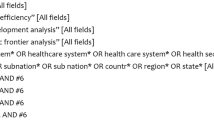Abstract
Since the mythical time of King Arthur, technology transfer has interested governments. Arthurian history revels in the exploits of the knights as they search for the Holy Grail. Always, it seems, finding it must mean the end to poverty, hunger, illness-all the sufferings of the kingdom. In early renditions of the legend, the Grail was a set of magical talismans to be stolen from the Celtic otherworld. With the coming of Christianity, the Grail evolved into a eucharistic vessel.
This paper focuses on the differences between technology transfer and technology transition while simultaneously emphasizing the impact of laboratory mission on the perceived importance of each task. The conceptual model presented highlights the difficulties inherent in changing the culture at federal laboratories.
Similar content being viewed by others
References
Antonini, Joseph E. “Organizational Renewal is More Than a New Logo.” Arthur Andersen & Co. SC:Retail Issues Newsletter 5, no. 3 (May–June 1993): 1–3.
Barley, Stephen R. “Semiotics and the Study of Occupational and Organizational Cultures.”Administrative Science Quarterly 28 (1983): 393–413.
Belk, Russell W.Manifesto for a Consumer Behavior of Consumer Behavior in Scientific Method in Marketing, edited by Paul Anderson and Michael J. Ryan, 163–167. Chicago: American Marketing Association, 1984.
Berry, Leonard L. “Organizational Renewal is More Than a New Logo.” Arthur Andersen & Co. SC:Retail Issues Newsletter 5, No. 3 (May–June 1993): 3–4.
Branscomb, Lewis M. “Does America Need a Technology Policy?”Harvard Business Review (March–April 1992): 24–31.
Burgelman, Robert A. “A Process Model of Internal Corporate Venturing in the Diversified Major Firm.”Administrative Science Quarterly (June 1983) 28: 223–244.
Carr Robert K. “Doing Federal Technology Transfer (Part 1).”The Journal of Technology Transfer 17, nos. 2 & 3 (Spring-Summer 1992): 8–23.
Carr, Robert K. “Menu of Best Practices (Part 2).”The Journal of Technology Transfer 17, nos. 2 & 3 (Spring-Summer 1992): 24–39.
Clancy, Tom.The Sum of All Fears, 435 New York: Jack Ryan Enterprises, Ltd., the Berkely Publishing Group, 1991.
Coursey, David, and Barry Bozeman. “Technology Transfer in U.S. Government and University Laboratories: Advantages and Disadvantages for Participating Laboratories.”IEEE Transactions on Engineering Management 39, no. 4 (November 1992): 347–351.
Deshpande, Rohit, “Paradigms Lost: On Theory and Method in Research in Marketing.”Journal of Marketing 47 (Fall 1983): 101–110.
Deshpande, Rohit, John U. Farley, and Frederick E. Webster, Jr. “Corporate Culture, Customer Orientation, and Innovativeness in Japanese Firms: A Quadrad Analysis.”Journal of Marketing 57 (January 1993): 23–27.
Eng, Sherri. “Federal Labs Roll out the Red Carpet for Business.”Investor's Business Daily (May 18, 1993): 4.
Executive Order 12591.Facilitating Access to Science and Technology. (April 10, 1987).
Feick, Lawrence F., and Linda L. Price. “The Market Maven: A Diffuser of Marketplace Information.”Journal of Marketing 51 (January 1987): 83–97.
Ford, David and Chris Ryan, “Taking Technology to Market.”Harvard Business Review, Vol. 59 (March–April 1981): 117–126.
Geertz, Clifford. Thick Description: Toward an Interpretive Theory of Culture, inThe Interpretation of Cultures, edited by Clifford Geertz, 231–267. New York: Basic Books (1973).
Gupta, A.K., and D.L. Wilemon. “Accelerating the Development of Technology-Based New Products.”IEEE Journal of Engineering Management Review (1990): 23–33.
Hammer Michael and James Champy.Reengineering The Corporation. New York, Harper Collins Publishers, Inc., 1993.
Holbrook, Morris B., and Elizabeth Hirschman. “The Experiential Aspects of Consumption: Consumer Fantasies, Feelings, and Fun.”Journal of Consumer Research 9, no. 2 (1982): 132–140.
Howell, Jane M., and Christopher A. Higgins. “Championts of Technological Innovation.”Administrative Science Quarterly 35 (June 1990): 317–341.
Kesting, W. Roy “Product Development and the Science of Chaos.”The Journal of Technology Transfer 18, nos. 1 & 2 (Winter-Spring 1993): 22–31.
Kotler, Philip. “Analyzing the Marketing Environment.” inMarketing Management: Analysis, Planning, Implementation, and Control, 150–171. Englewood Cliffs, NJ: Prentice Hall, Inc., 1994.
Lincoln, Yvonna S., and Egon G. GubaNaturalistic Inquiry. Bevely Hills: Sage, 1985.
Public Law 96-480.Stevenson-Wydler Act 1980. Title 15, Section 3701-3714. October 21, 1980.
Public Law 99-953.Stevenson-Wydler Technology Innovation Act of 1986. 1986.
Public Law 100-519.National Institute of Standards and Technology Authorization Act for FY 1989. 1989.
Rood, Sally A. “Legislative-Policy Initiatives As a Problem-Solving Process: The Case of Technology Transfer.”The Journal of Technology Transfer (Winter 1989): 14–25.
Schriesheim, Alan. “Toward a Golden Age for Technology Transfer.”Issues in Science and Technology 7, no. 2 (1991): 52–55.
Sexton, Donald L., and S. Michael Camp. “Technology Transfer and Value Creation.”The Journal of Technology Transfer 17, nos. 2 & 3 (Spring-Summer 1992): 68–76.
Spivey, W. Austin, J. Michael Munson, and William T. Flannery. “Interest in Technology Transfer across Academic Disciplines: Publication Trends, 1981 thru 1989.”The Journal of Technology Transfer 15, no. 3 (Summer 1990): 13–20.
Thompson, Craig J., William B. Locander, and Howard R. Pollio. “Putting Consumer Experience Back into Consumer Research: The Philosophy and Method of Existential-Phenomenology.”Journal of Consumer Research 16 (September 1989): 133–146.
Tornatzky, Louis G., J. D. Eveland, Myles G. Boylan, William A. Hetzner, Elmima C. Johnson, David Roitman, and Janet Schneider.The Process of Technological Innovation: Reviewing the Literature. National Science Foundation, 1983.
Von Hippel Eric “Lead Users: A Source of Novel Product Concepts.”Management Science 32, no. 7 (July 1986): 352–366.
Zhao, Liming, and Arnold Reisman. “Toward Meta Research on Technology Transfer.”IEEE Transactions on Engineering Management 39, no. 1 (February 1992): 13–21.
Rights and permissions
About this article
Cite this article
Spivey, W.A., Munson, J.M. & Flannery, W.T. Understanding the environs that impact technology transfer and transition. J Technol Transfer 19, 63–73 (1994). https://doi.org/10.1007/BF02371414
Issue Date:
DOI: https://doi.org/10.1007/BF02371414




